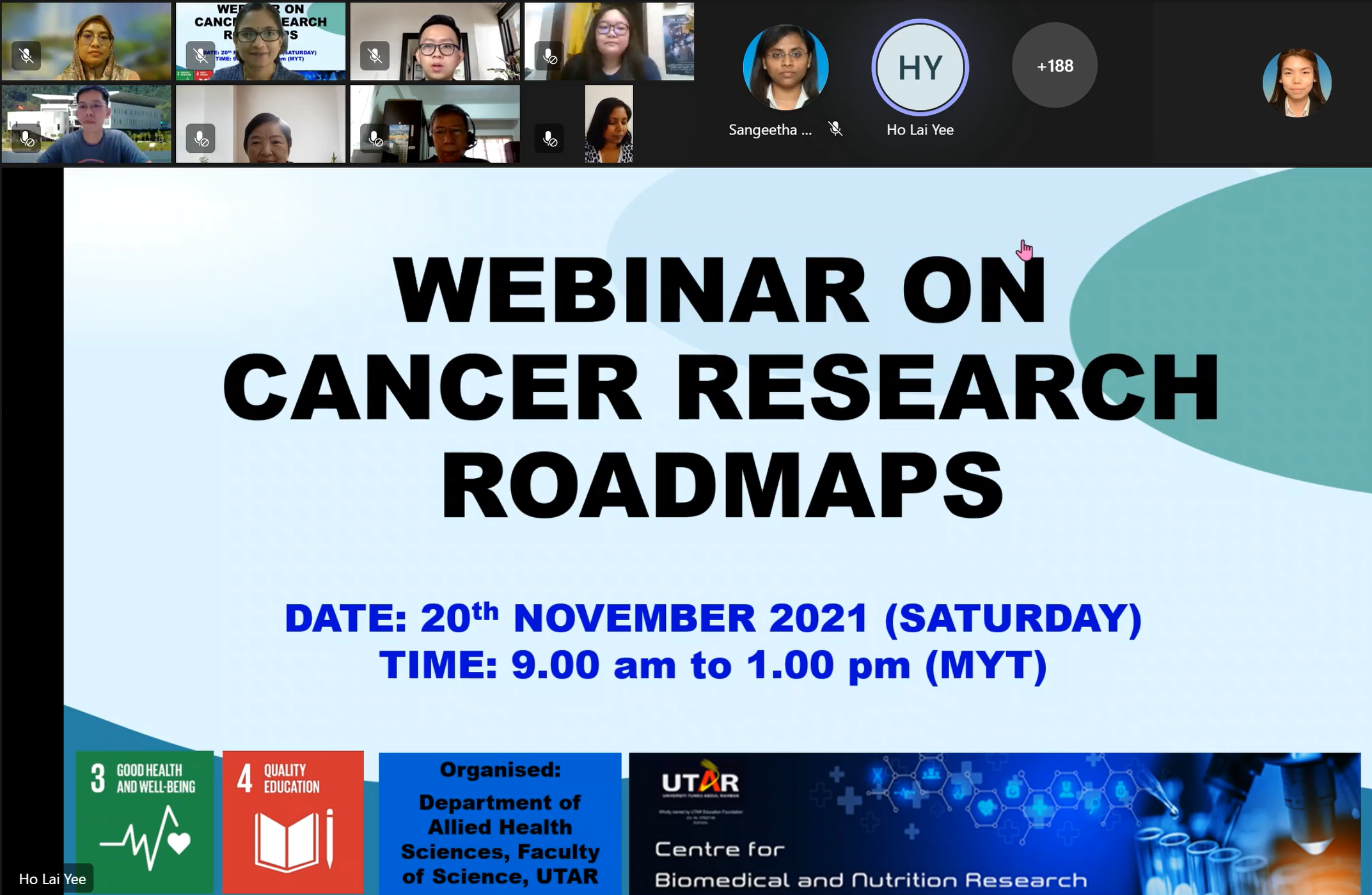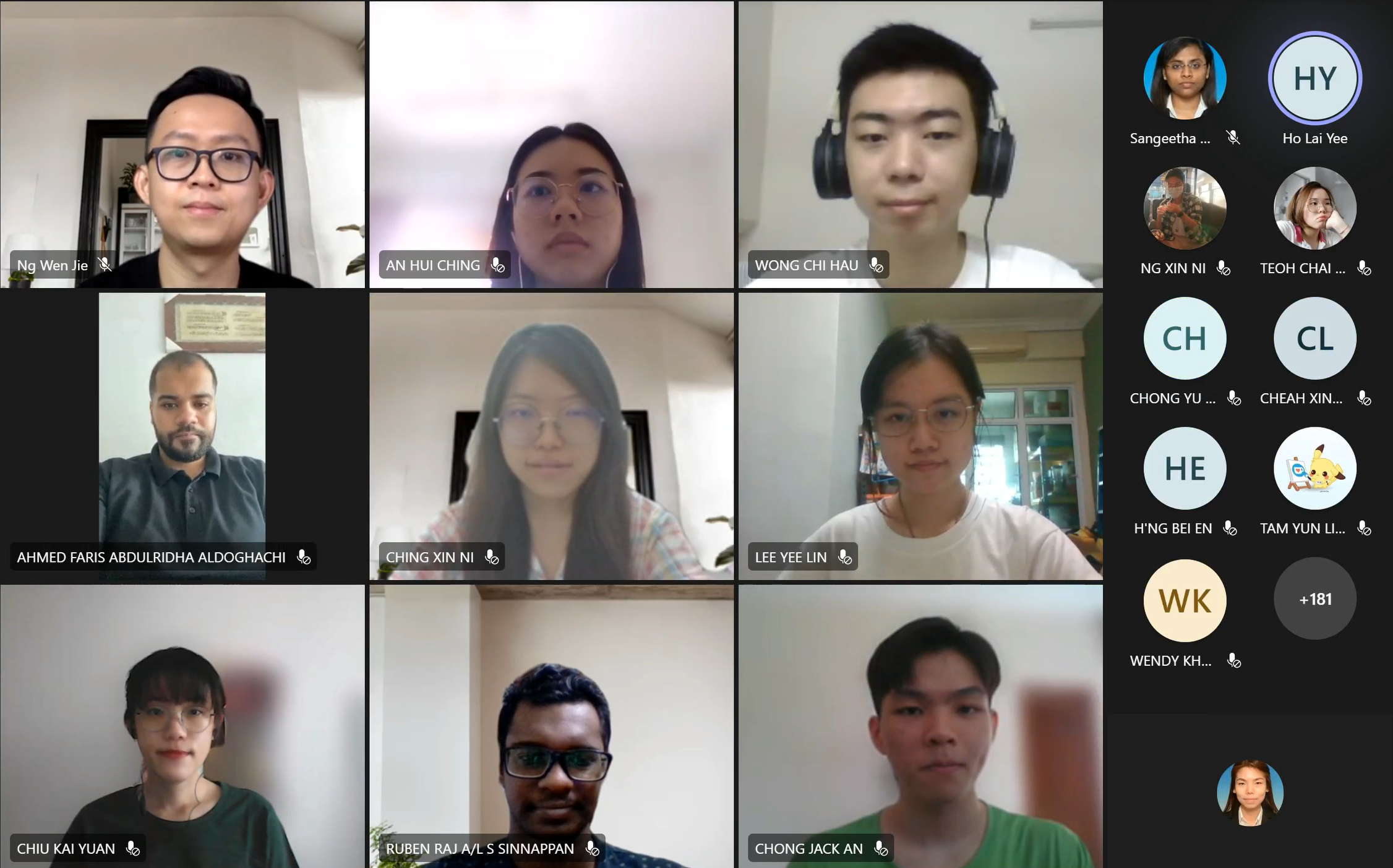
The Centre for Biomedical and Nutrition Research and the Department of Allied Health Sciences from the Faculty of Science organised “Webinar on Cancer Research Roadmaps” on 20 November 2021. The event saw about 200 participants in attendance.

Speaking at the webinar were Institute for Medical Research, Selangor Head of Haematology Unit-cum-Head of Cancer Research Centre Dr Ezalia Esa, Women and Children’s Hospital, Kuala Lumpur Head of Molecular Genetics Unit Dr Stephen Ponnapalam and University Malaya Medical Centre Kuala Lumpur Clinical Oncology Trainee Dr Rufus Jesudass while moderating the webinar was Consultant Pathologist (Haematology and Cytogenetics) Kuala Lumpur Dr Zubaidah Zakaria.
The webinar aimed to identify the importance of cancer prevention, early detection diagnosis and conventional cancer therapies in areas of surgery, radiotherapy and chemotherapy. Aside from that, the webinar exposed the participants to the current trends in the prevention, diagnosis, and treatment of cancers and instilled awareness among students and the public on the latest research and progress of cancer.

Dr Ezalia during her presentation
Dr Ezalia presented her topic on “Haematological Malignancies: Cytogenetics and Molecular Genetics” where she spoke about haematological malignancies, basis tests to diagnose the case, bone marrow cytogenetic, fluorescence in situ hybridisation, microarray, molecular genetics and advanced molecular genetic tests. “Haematological malignancies are composed of a diverse group of cancers that affect the blood, bone marrow and lymphatic systems. The diagnosis is dependent on the correlation of the clinical details with a combination of several laboratory technologies. The diagnosis of each entity is systematically classified according to the latest WHO classification of tumours of hematopoietic and lymphoid tissues 2016,” she said.
She added, “Laboratory test is pathology specific. Each haematological neoplasm is defined by a spectrum of genetic aberrations of diagnostic and/or prognostic significance and the testing required is pathology specific. We recommend different or combined technology approach to diagnose these cases and it is recognised that testing is a rapidly evolving field and the introduction of new technologies will vary between laboratories and from country to country.”

Dr Rufus sharing his knowledge with participants
Dr Rufus shared his presentation titled “Cancer Immunology and Treatment Advancements”. He spoke about emerging hallmarks and enabling characteristics, cancer immunology, cell death, cancer immunity cell, types of professional antigen presenting cells (APCs), activation of tumour-specific T cells by APCs, tumour antigens, antibody mechanism of action, conceptual developments in cancer immunology and other related topics.
“Tumour-specific antigen is expressed on tumour cells but not on normal cells. A tumour-associated antigen is expressed on tumour cells but it is also found on normal cells and is often in smaller amounts. Efficient anti-tumour strategies must focus on hitting different targets concurrently. Key nodes to target in combination treatment is to abrogate immune suppression, induce immunogenic cancer cell death, enhance antigen presentation and induce activation and survival of immune effector cells,” said Dr Rufus.

Dr Stephen during the Q&A session
Dr Stephen presented on “RNA as a Screening Tool and Biomarker for Disease: A Paradigm Shift in Medical Risk Stratification” where he spoke about the characteristics of an ideal biomarker, DNA versus RNA as a biomarker for risk stratification, sentinel principle, epidemiology of disease mortality in Malaysia with a focus on cancer, current biomarkers and the drawbacks; ColonSentry, a trailblazer of the sentinel principle application and the future of biomarkers. He said, “The characteristics of an ideal tumour marker must be highly sensitive, highly specific, long lead-time, levels correlate with tumour burden, short half-life, simple and cheap test as well as easily obtainable specimens.”
He added, “Blood is in intimate contact and interacts with all human tissues including cancerous tissue. Peripheral blood cells have the ability to respond to changes in the physiology and microenvironment of the body. The sentinel principle can be used as an early biomarker to detect changes in the body including the earliest of changes that occur in cancer. The top five causes of death in men are heart disease, pneumonia, road accidents, stroke and lung cancer while the top five causes of death in women are pneumonia, heart disease, stroke, breast cancer and road accidents. RNA is a current biomarker and a biomarker for the future. Other biomarkers for the future include Decoy receptors, SRAGE, Immuno-modulators.”
Faculty of Science Dean Assoc Prof Dr Lim Tuck Meng said, “I would like to thank all the speakers who have taken their effort and time to summarise and highlight to us the recent development in research of cancer. It is important for the people in society to make their decision based on accurate and correct information to avoid making wrong decisions that hinder progress. We look forward to many more interesting events in the future that would benefit the society,” as the webinar ended.

Participants taking group photograph
© 2021 UNIVERSITI TUNKU ABDUL RAHMAN DU012(A).
Wholly owned by UTAR Education Foundation (200201010564(578227-M)) LEGAL STATEMENT TERM OF USAGE PRIVACY NOTICE